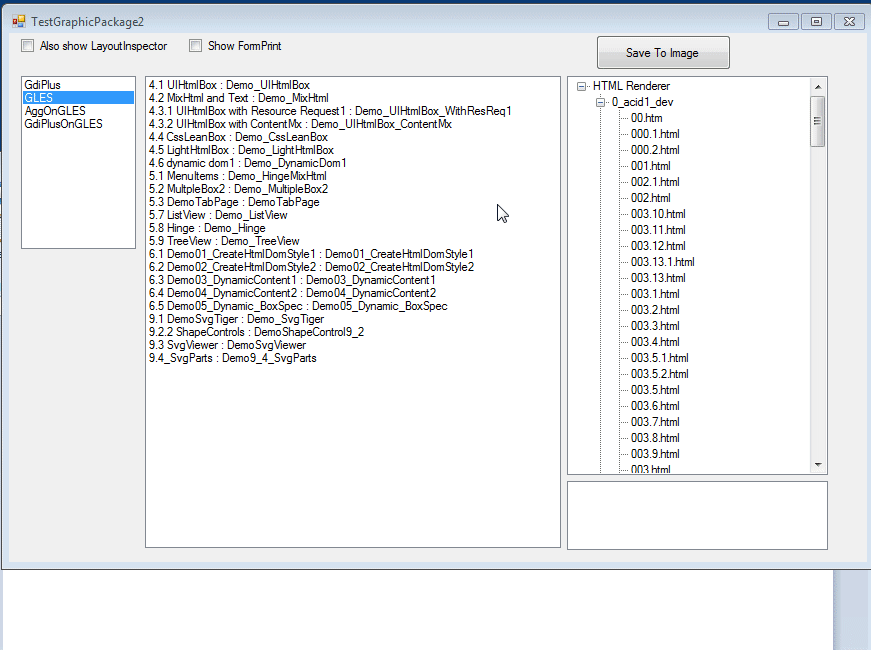Hello !
pic 1: HtmlRenderer, Gdi+, see test file
seems promising ?, NEARLY pass ACID1 test :)
Work In Progrss ... : Cross Platform HtmlRenderer
 pic 2: HtmlRenderer on GLES2 surface, text are renderered with the Typography
pic 2: HtmlRenderer on GLES2 surface, text are renderered with the Typography
 pic 3: HtmlRenderer on GLES2 surface
pic 3: HtmlRenderer on GLES2 surface
also, please note the text selection on the Html Surface.
(HtmlRender => https://github.com/LayoutFarm/HtmlRenderer,
Typography => https://github.com/LayoutFarm/Typography)
How to build it
see https://github.com/LayoutFarm/HtmlRenderer.Build
Work In Progrss ... : Html-input
Html input elements are built with 'html-fragment (sub dom)'
see more at #18
pic3 : HtmlRenderer on GLES2 surface,developing Html-input, click to view full size img
pic 4: HtmlRenderer's Classic, Gdi+
MORE info / screen capture imgs -> see wiki
Build Note -> see wiki
I forked this project from https://github.com/ArthurHub/HTML-Renderer (thank you so much)
I added some features
such as
-
dynamic html dom
-
decoupling, dependency analysis
-
optimizing the html,css parser. see: HtmlKit v1.0(https://github.com/jstedfast/HtmlKit)
-
add svg/canvas support (not complete)
-
abstract canvas backend (GDI+, OpenGL) also not complete for Linux (for the canvas backend, I used it from another project ->https://github.com/prepare/PixelFarm-dev)
-
Javascript (v8) binding (https://github.com/prepare/Espresso)
-
debug view
-
more layout support eg. inline-block,relative, absolute ,fixed, flex etc
-
added custom controls eg. text editer control, scrollbar, gridbox etc.
-
some events (eg. mouse /keyboard events)
.. BUT not complete :(
feel free to fork/ comment/ suggest /pull request
Plan
-
always permissive license (MIT,BSD, Apache2)
-
bind some features from Blink engine
-
add more html5/css3/js support
-
convert to C++ code with some transpiler tools so users can build a final native code web browser
-
to make this runs on .NetCore
Licenses
The project is based on multiple open-sourced projects (listed below) all using permissive licenses.
A license for a whole project is MIT.
but if you use some part of the code please check each source file's header for the licensing info.
Html Engine
BSD, 2009, José Manuel Menéndez Poo, https://www.codeproject.com/Articles/32376/A-Professional-HTML-Renderer-You-Will-Use
BSD, 2013-2014, Arthur Teplitzki, from https://github.com/ArthurHub/HTML-Renderer
MIT, 2015, Jeffrey Stedfastm, from HtmlKit https://github.com/jstedfast/HtmlKit
Javascript Engine
MIT, 2013, Federico Di Gregorio, from https://github.com/Daniel15/vroomjs
MIT, 2015-present, WinterDev, from https://github.com/prepare/Espresso
Geometry
BSD, 2002-2005, Maxim Shemanarev, from http://www.antigrain.com , Anti-Grain Geometry - Version 2.4,
BSD, 2007-2014, Lars Brubaker, agg-sharp, from https://github.com/MatterHackers/agg-sharp
ZLIB, 2015, burningmine, CurveUtils.
Boost, 2010-2014, Angus Johnson, Clipper.
BSD, 2009-2010, Poly2Tri Contributors, from https://github.com/PaintLab/poly2tri-cs
SGI, 2000, Eric Veach, Tesselate.
Image Processing
BSD, 2002-2005, Maxim Shemanarev, from http://www.antigrain.com , Anti-Grain Geometry - Version 2.4,
MIT, 2009-2015, Bill Reiss, Rene Schulte and WriteableBitmapEx Contributors, https://github.com/teichgraf/WriteableBitmapEx
MIT, 2008, dotPDN LLC, Rick Brewster, Chris Crosetto, Tom Jackson, Michael Kelsey, Brandon Ortiz, Craig Taylor, Chris Trevino, and Luke Walker., from OpenPDN v 3.36 (Paint.NET), https://github.com/rivy/OpenPDN
Font
MIT, 2016-present, WinterDev, Samuel Carlsson, Sam Hocevar and others, from https://github.com/LayoutFarm/Typography
Apache2, 2014-2016, Samuel Carlsson, from https://github.com/vidstige/NRasterizer
MIT, 2015, Michael Popoloski, from https://github.com/MikePopoloski/SharpFont
The FreeType Project LICENSE (3-clauses BSD style),2003-2016, David Turner, Robert Wilhelm, and Werner Lemberg and others, from https://www.freetype.org/
MIT, 2016, Viktor Chlumsky, from https://github.com/Chlumsky/msdfgen
Platforms
MIT, 2015-2015, Xamarin, Inc., from https://github.com/mono/SkiaSharp
MIT, 2006-2009, Stefanos Apostolopoulos and other Open Tool Kit Contributors, from https://github.com/opentk/opentk
MIT, 2013, Antonie Blom, from https://github.com/andykorth/Pencil.Gaming
MIT, 2004,2007, Novell Inc., for System.Drawing
Long Live Our Beloved C#
WinterDev :)



















